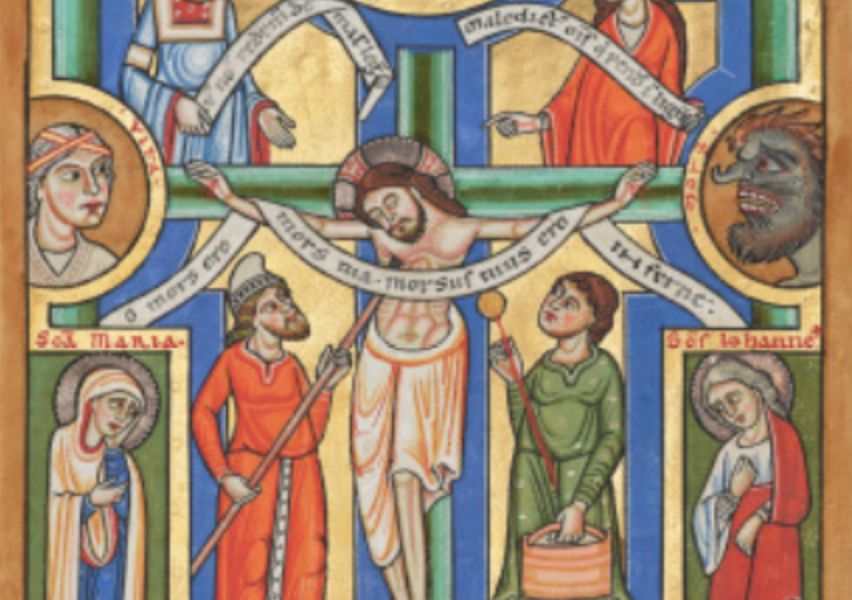“The root of all disturbance, if one will go to its source, is that no one will blame himself.” — Dorotheus of Gaza, sixth-century monk
Through April 8, the Getty Center is featuring an exhibit of illuminated manuscripts titled “Outcasts: Prejudice and Persecution in the Medieval World.”
To prepare, I read Christopher de Hamel’s “Meetings with Remarkable Manuscripts,” a delightful entrée to the millennia of history, obsessive scholarship and arcane world of palace intrigues that characterize these splendid worship aids and works of art. (“Illuminated” refers to the frequent use of gold leaf).
The Getty is an L.A. treasure. I am grateful to it. I really wanted to like “Outcasts.”
But within seconds I felt the spikes of contemporary “identity politics” being driven into my hands and feet.
The opening commentary set the tone.
“Life provided significant obstacles for those who were not fully-abled, white, wealthy, Christian, heterosexual, cisgender males. For today’s viewer, the vivid images and pervasive subtexts in illuminated manuscripts can serve as stark reminders of the power of rhetoric and the danger of prejudice.”
Cisgender? A term invented and that came into usage in the 1990s? Oh those hateful bigots of the Middle Ages, with their backward insistence upon a sense of personal identity and gender that actually corresponded with their birth sex!
The exhibit does allow that in medieval times the physical care of the indigent and outcast was fulfilled by religious, and that nuns in particular ministered to lepers. It gives a nod to Martin de Tours, who famously cut his cloak in two and gave half to a beggar.
Other than that, the commentary gives the general impression that the follower of Christ, then as now, is viciously anti-Semitic, and a hater of people of color, gay people, women, the poor and sex.
“King Haldin Accusing the Sultan’s Daughter of Dishonorable Behavior” (Belgium, circa 1464) is typical. It was a fellow Muslim who maligned the sultan’s daughter’s chastity. A Christian knight then fell in love with and married her.
This is interpreted as “the trope of the Christian convert” and, inexplicably, as a slur against Christianity.
Would the guy have been more stand-up had he kept the sultan’s daughter as a concubine, or simply slept with and discarded her?
“St. Martin Dividing His Cloak,” circa 1469, appeared in a prayer book of Charles the Bold. An exquisite illustration, you might think, but no: an illustration casting suspicion on its subject by the fact that the image at the bottom of the page, in contrast to St.Martin’s charity, “features a mock joust between two peasants with baskets on their heads, thus making a joke at the expense of the poor.”
As further evidence of Christian hypocrisy, we then learn that the owner of the manuscript was rich. You had to be rich to own an illuminated manuscript. You have to be rich now.
Because J. Paul Getty was rich, should we consider every item in his museum fatally tainted? Or is wealth prima facie hypocritical and discriminatory only in a Christian?
It goes on like that: The inclusion of a black African magus in “The Adoration of the Magi” (circa 1480) is putatively negated by the fact that at the same time “Europeans began to engage in the brutal African slave trade.”
The erasure of “Abraham and Hagar Having Intercourse” is a sign of “the power of images to solicit moral judgments, in particular of encounters with people deemed foreign or ‘other.’ “
But since Abraham was a married Hebrew patriarch and Hagar was an Egyptian slave, the encounter was very probably on the order of a rape.
Could compassion have been the reason the illustration was erased? Or gallantry? But no, gallantry these days is also increasingly deemed discriminatory on its face.
The crucifixion itself, the center of Christianity and depicted beautifully in the exhibit, is of course overlooked completely — the brutal torture and death of a man who was himself poor, himself an outcast, who took upon himself all prejudice, all discrimination, all loneliness, all cruelty, all fear and hatred of “The Other.”
George Santayana is ominously quoted: “Those who cannot remember the past are condemned to repeat it.” But those who really remember the past will recall that when the oppressed are liberated, quite without the aid of any religion, they often in turn visit oppression on others equal to or worse than that they suffered themselves.
I thought of philosopher Rene Girard’s “The Scapegoat”:
“[T]he Gospels reveal the scapegoat mechanism everywhere, even within us. … Jesus intervenes … when violence can no longer cast out violence and internal division has reached its crisis. ... Thus we come to understand what is involved in the Kingdom of God and why it does not represent for men an unmitigated blessing. It has nothing to do with a flock of sheep grazing in an eternally green pasture. It brings men face to face with their hardest task in history.
“There is only one transcendence in the Gospels, the transcendence of divine love that triumphs over all manifestations of violence and the sacred by revealing their nothingness.”
Such is our task as we enter into Lent.
Heather King is a blogger, speaker and the author of several books.

